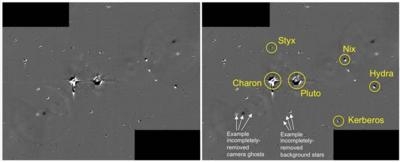Given Green Light For July 14 Flyby Of The Dwarf Planet
NASA’s New Horizons spacecraft is getting a final “all clear” as it speeds closer to its historic July 14 flyby of Pluto and the dwarf planet’s five moons.

After seven weeks of detailed searches for dust clouds, rings, and other potential hazards, the New Horizons team has decided the spacecraft will remain on its original path through the Pluto system instead of making a late course correction to detour around any hazards. Because New Horizons is traveling at 30,800 mph (49,600 kph), a particle as small as a grain of rice could be lethal.
“We’re breathing a collective sigh of relief knowing that the way appears to be clear,” said Jim Green, director of planetary science at NASA. “The science payoff will be richer as we gather data from the optimal flight path, as opposed to having to conduct observations from one of the back-up trajectories.”
Mission scientists have been using the spacecraft’s most powerful telescopic camera, the Long Range Reconnaissance Imager (LORRI), to look for potential hazards, such as small moons, rings, or dust, since mid-May. The decision on whether to keep the spacecraft on its original course or adopt a Safe Haven by Other Trajectory, or "SHBOT" path, had to be made this week since the last opportunity to maneuver New Horizons onto an alternate trajectory was July 4.
“Not finding new moons or rings present is a bit of a scientific surprise to most of us,” said principal investigator Alan Stern of the Southwest Research Institute (SwRI) in Boulder, Colorado. “But as a result, no engine burn is needed to steer clear of potential hazards. We presented these data to NASA for review and received approval to proceed on course and plan. We are ‘go’ for the best of our planned Pluto encounter trajectories.”
New Horizons formed a hazard analysis team in 2011, after the discovery of Pluto’s fourth moon, Kerberos, raised concerns the cratering of these moons by small debris from the outer area of the solar system known as the Kuiper Belt, could spread additional hazardous debris into New Horizons’ path. Mission engineers re-tested spare spacecraft blanketing and parts back on Earth to determine how well they would stand up to particle impacts, and scientists modeled the likely formation and locations of rings and debris in the Pluto system. By the time New Horizons’ cameras were close enough to Pluto to start the search last month, the team had already estimated the chances of a catastrophic incident at far less than one percent.
The images used in the latest searches that cleared the mission to stay on its current course were taken June 22, 23 and 26. Pluto and all five of its known moons are visible in the images, but scientists saw no rings, new moons, or hazards of any kind. The hazards team determined that satellites as faint as about 15 times dimmer than Pluto’s faintest known moon, Styx, would have been seen if they existed beyond the orbit of Pluto’s largest and closest moon, Charon.
If any rings do exist, the hazard team determined they must be extremely faint, reflecting less than one 5-millionth of the incoming sunlight.
“The suspense – at least most of it – is behind us,” says John Spencer, of SwRI, who leads the New Horizons hazard analysis team. “As a scientist I’m a bit disappointed that we didn’t spot additional moons to study, but as a New Horizons team member I am much more relieved that we didn’t find something that could harm the spacecraft. New Horizons already has six amazing objects to analyze in this incredible system.”
(Image provided by NASA)
 ANN's Daily Aero-Term (05.10.24): Takeoff Roll
ANN's Daily Aero-Term (05.10.24): Takeoff Roll Aero-News: Quote of the Day (05.10.24)
Aero-News: Quote of the Day (05.10.24) Aero-News: Quote of the Day (05.11.24)
Aero-News: Quote of the Day (05.11.24) ANN's Daily Aero-Term (05.11.24): IDENT Feature
ANN's Daily Aero-Term (05.11.24): IDENT Feature ANN's Daily Aero-Linx (05.11.24)
ANN's Daily Aero-Linx (05.11.24)



